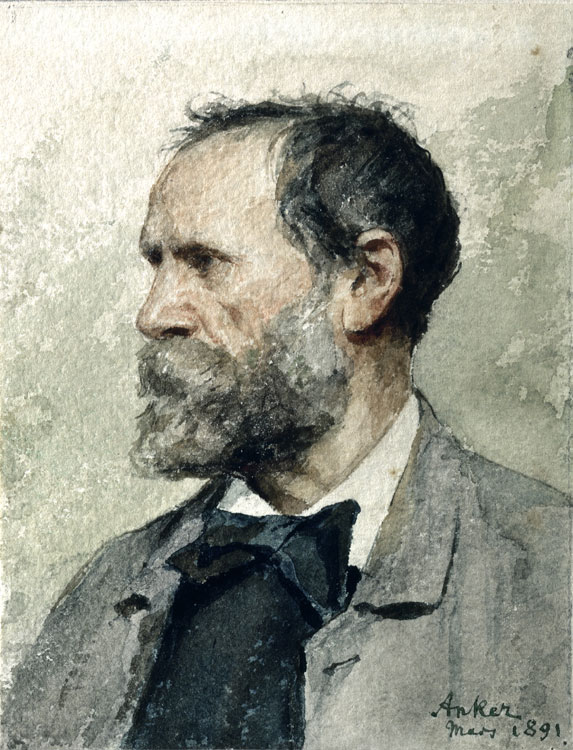- Albert Anker
Infobox Person
name = Albert Samuel Anker

image_size = 200px
caption = "Self-portrait in profile, left" (1891)
Watercolours, 16.3 × 12.7 cm
birth_date =April 1 1831
birth_place =Ins, Switzerland
death_date =July 16 1910
death_place =
education =
occupation = Painter
spouse = Anna Rüfli
parents =
children = Louise, Marie, Maurice and CécileAlbert Samuel Anker (
April 1 1831 –July 16 1910 ) was a Swiss painter andillustrator who has been called the "national painter" of Switzerland because of his enduringly popular depictions of 19th-century Swiss village life.cite web|title=Albert Anker|first=Therese|last=Bhattacharya-Stettler|publisher=Swiss Institute for Art Research |work= [http://www.sikart.ch/page.php?pid=30&name=impressum&lang=en SIKART dictionary and database] |language=German|year=1998|url=http://www.sikart.ch/artikel4000009.pdf]Life
Born in
Ins as the son ofveterinarian Samuel Anker (then a member of theconstituent assembly of theCanton of Berne ), Anker attended school inNeuchâtel , where he andAuguste Bachelin , later a fellow artist, took early drawing lessons withLouis Wallinger in 1845–48. In 1849–51, he attended theGymnasium Kirchenfeld inBerne , graduating with the "Matura ." Afterwards, he studiedtheology , beginning in 1851 in Berne and continuing at the university of Halle,Germany . But in Germany he was inspired by the great art collections, and in 1854 he convinced his father to agree to an artistic career.Anker moved to
Paris , where he studied withCharles Gleyre and attended theEcole Impériale et Spéciale des Beaux-Arts in 1855–60. He installed a studio in the attic of his parents' house and participated regularly in exhibitions in Switzerland and in Paris. Anker married Anna Rüfli in 1864, and they had six children together; the four children who did not die at an early age – Louise, Marie, Maurice and Cécile – appear in some of Anker's paintings. In 1866, he was awarded a gold medal at the Paris Salon for "Schlafendes Mädchen im Walde" (1865) und "Schreibunterricht" (1865); in 1878 he was made a knight of theLégion d'honneur . In 1870–74 he was a member of theGrand Council of Bern , where he advocated the construction of theKunstmuseum Bern .Apart from his regular wintertime stays in Paris, Anker frequently travelled to Italy and other European countries. In 1889–93 and 1895–98 he was a member of the Swiss Federal Art Commission and in 1900 he received a
honorary doctorate from theUniversity of Berne . Astroke in 1901 reduced his ability to work. Only after his death in 1910 was there a first exposition dedicated to him, held at the Musée d'art et d'histoire in Neuchâtel.Works
During his studies, Anker produced a series of works with historical and biblical themes, including paintings of Luther and Calvin. Soon after returning to Ins, though, he turned to what would become his signature theme: the everyday life of people in rural communities. His paintings depict his fellow citizens in an unpretentious and plain manner, without idealising country life, but also without the critical examination of social conditions that can be found in the works of contemporaries such as
Daumier ,Courbet or Millet. Although Anker did paint occasional scenes with a social significance, such as visits by usurers or charlatans to the village, his affirmative and idealistic Christian world-view did not include an inclination to issue any sort of overt challenge.Also prominent in Anker's work are the more than 30
still life s he created. They depict both rural and urban table settings in the tradition of Chardin, their realist solidity reflecting Anker's vision of a harmonic and stable world order. In addition, Anker created hundreds of commissioned watercolours and drawings, mostly portraits and illustrations, including for an edition ofJeremias Gotthelf 's collected works. To provide for a steady income, Anker also decorated more than 500faience plates for the Alsatian producerThéodore Deck .Anker was quick to reach his artistic objectives and never strayed from his chosen path. His works, though, exude a sense of conciliation and understanding as well as a calm trust in
Swiss democracy ; they are executed with great skill, providing brilliance to everyday scenes through subtle choices in colouring and lighting. Their parochial motives belie the open-mindedness towards contemporary European art and events that Anker's correspondence reflects.Reception
Albert Anker's work made him Switzerland's most popular genre painter of the 19th century, and his paintings have continued to enjoy a great popularity due to their general accessibility. Indeed, as a student, Anker summed up his approach to art as follows: "One has to shape an ideal in one's imagination, and then one has to make that ideal accessible to the people."
Many Swiss
postage stamp s and other media have incorporated Anker's work. His studio in Ins has been preserved as a museum by the Albert Anker Foundation. One of Anker's greatest admirers and collectors is former Federal CouncillorChristoph Blocher , since the 1980s Switzerland's most influential conservative politician, who also published an apologetic essay on Anker. [cite news|author=Christoph Blocher |title=Schweizer Malerei: Tröstlich anzusehen|publisher=Die Weltwoche 17/06 |date=2006|url=http://www.weltwoche.ch/artikel/?AssetID=13831&CategoryID=80|language=German]Gallery
References
Bibliography
* H.A. Lüthy, S. Kuthy, "Albert Anker" (1980) (German)
* S. Kuthy, T. Bhattacharya-Stettler, "Albert Anker, Ölgemälde und Ölstudien" (1995) (German)External links
*SIKART|4000009
*HDS|21975
* [http://www.albert-anker.ch www.albert-anker.ch]
* [http://www.zona-pellucida.com/anker.html Albert Anker paintings online]
Wikimedia Foundation. 2010.
